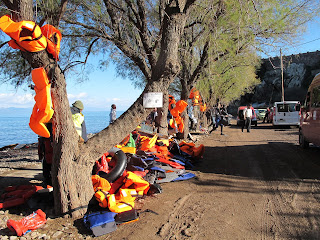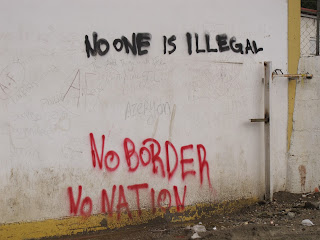Samos Day 1 - January 9, 2016
I took the first part of the morning to get the lay of the land and getting organized – renting a car, arranging lodging for the rest of my stay, and finding the camp. When I arrived the clinic was not yet open and people were starting to arrive after arriving on the boats last night and form queues.
I am still a bit confused about the process but it sounds like once a boat has landed and help can get to them, MSF runs a big bus that will then take them to one of two camps depending on their nationality. The clinic I will work at is at the port and houses Syrian, Iraq, and Afghan refugees. Due to the weather lately few families were there. There were some boats that crossed in the night and early morning and by the day’s end about 300 people were present.
It gets more confusing because some families do not sleep in the camps but find more comfortable lodgings in a hotel.
There is also another camp, the screening center, that houses everyone else (non Syrians, Iraqis and Afghanis). There is an estimated 1000 people there and I am getting conflicting responses as to how long they have been there and how long they will stay. The process for those not considered refugees but are designated are migrants has varied from each island I am will be interested to know what will happen. No doubt they will be sent back to their home country but how and when is a mystery.
To further complicate the situation on Samos is the lack of a clear place where the boats land. Turkey is very close but the nearest point is a peninsula of land with no roads and is impossible to post a lookout at all points. They often will also land on the north side of the island – anywhere the current and the small motors can carry them – but this is too large of an area to monitor and the beaches are often down steep trails and cliffs. The Swedish Coast Guard is monitoring the waters but they can’t be everywhere at once. This means people may land and no one will know they are there for hours and then it takes time for help to arrive.

I met one family who has been traveling for over 3 weeks from Syria. The husband was a nurse and he, his parents, his wife and their two young children have journeyed and were very tired, walking for days at a time. The boat ride in last night was cold, wet, and terrifying and they spent the night on a rocky hillside in the wind until help arrived this morning. To make matters worse, the terrain they had to traverse was steep and rocky, difficult for the young and spry but almost impossible for the frail and elderly. His mother fell twice and hurt her back and knee. By the time they made it into the clinic her knee was twice as big as her healthy one and she could not walk at all. Pain medication was given and x-rays were recommended at the nearest hospital but they were too tired to consider that just now. Not once did she complain about her pain or the little we could do for her and instead she was grateful for our care and bestowed us with blessings.
They had not showered or washed at all in that 3 week time and though it was more than they could comfortably afford they spent the $90 for a hotel for their family to shower and rest. When speaking with the young father his daughter came up to me and hugged me tight – at first glance. She must have been 5 years old and her trust and heart filled with such love filled me with joy. They allowed me a photograph of them but I will not post it here to protect their privacy. His brother is in Sweden and that is where they hope to arrive soon – but Sweden is currently making it more difficult for refugees seeking asylum and having family already there is not a guarantee. I wish them all the best and will always wonder how they fared.

Since the camp is so small compared to most the volunteers are trying to offer respite in any way they can. Just this past week they borrowed a screen and started screening nightly movies in the clinic waiting area - tonight was Pink Panther cartoons and Mr. Bean – movies that entertain and need no language to understand. What a treat to see such happy faces on the children and adults alike and to give the parents a chance to rest.
At the peak last summer Samos averaged over 1000 refugees/day, its biggest day 2500. Today approximately 200 people arrived, but that total isn’t clear. The port police keep different statistics from the other police and we do not know how many arrived in totality for both camps. For now, though, it is considered quiet and manageable. I can’t imagine what it is like in the summer when the seas are calmer and more people are entering.
The clinic is staffed by an RN from France with Women and Health Alliance International (WAHA) and an MD from the Hellenic CDC who are kept busy from 2pm-9pm, often later. They open then because that is when people arrive from the screening center. Today a volunteer nurse from Denmark joined them for 2 weeks and I pitched in as well. It was fortunate she was there because even though she is not an interpreter she does speak some Arabic and was able to help with communication.
We saw everything from respiratory illnesses to infected feet. Lots of sick children and babies and I managed to do some women’s health and prenatal care as well which excited the MD who tirelessly staffs the clinic as I brought my equipment, personal pharmacy, and expertise. It was very rewarding and humbling – but the team was fun as well and we had a good time doing it. In addition the clinic has some supplies to offer families in need: wheelchairs (which they give to the person who needs it to take with them), socks, gloves, children’s coats to name a few.
 |
| Linea, Laureli, Manos |
I was also called in to help with fitting baby carriers. Unfortunately the only carriers available were the tie kind which I was able to help put on the mothers and fathers and demonstrate on another volunteer. The families looked at me with pleading eyes and will no doubt do their best when it is their turn to put them on and somehow make them work, but they are too complicated to learn quickly and not practical. We even provided a card with illustrations to assist but it was more than they could manage. I will make a plea to Carry the Future to get some user friendly carriers to Samos as soon as possible.
Memories:
The 13 year old with feet so swollen and raw it hurt to look at them, I actually almost cried when he took off his socks. He did not complain when walking, though he did hobble. His family had been traveling for almost 4 weeks and his feet started hurting 10 days ago. This was common due to the continuous wet conditions and sometimes with ill fitting shoes as well. He was provided with dry shoes and socks as well as medication and instructions to keep his feet open to the air – but that will not be possible other than his time here. And given how cold it is right now doubtful he can manage for long when not traveling.
The young pregnant woman with a sick 2 year old, so hungry and tired. She had not eaten in 2 days when she arrived at the camp and then only had a few biscuits. Soup was to be served later that night and that would be her meal for the day. Her husband was not with her and there was no interpreter to ask where he was or if he was even alive.
Countless children without shoes and many without coats. The volunteer distribution center was doing their best but they ran out early and would not get more until late at night for the next day. And it was cold out – too cold for young children to be barefoot which did not help them stay healthy. Tired, cold, often in cramped quarters with no way to wash or protect themselves from illness.




























